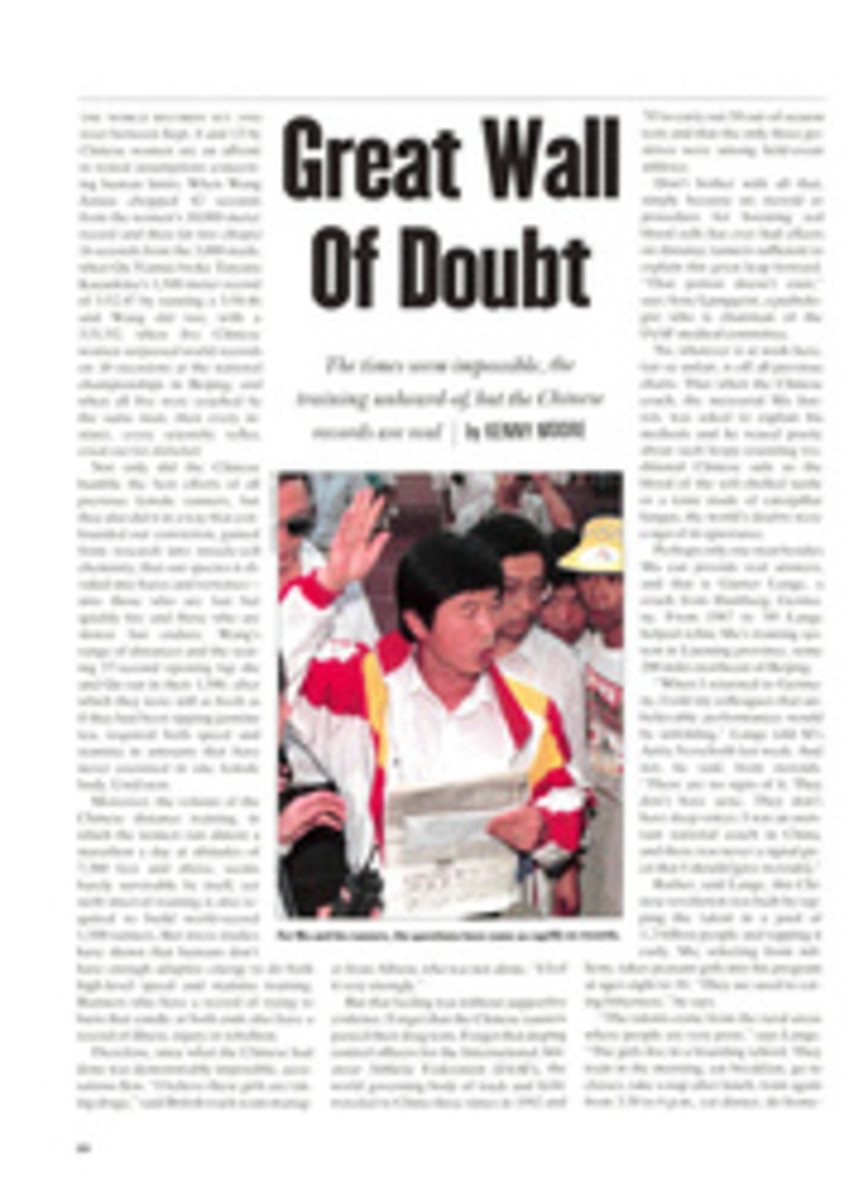
Great Wall Of Doubt
The world records set and reset between Sept. 8 and 13 by Chinese women are an affront to tested assumptions concerning human limits. When Wang Junxia chopped 42 seconds from the women's 10,000-meter record and then (in two chops) 16 seconds from the 3,000 mark; when Qu Yunxia broke Tatyana Kazankina's 1,500-meter record of 3:52.47 by running a 3:50.46 and Wang did too, with a 3:51.92; when five Chinese women surpassed world records on 10 occasions at the national championships in Beijing; and when all five were coached by the same man, then every instinct, every scientific reflex, cried out for disbelief.
Not only did the Chinese humble the best efforts of all previous female runners, but they also did it in a way that confounded our conviction, gained from research into muscle-cell chemistry, that our species is divided into hares and tortoises—into those who are fast but quickly tire and those who are slower but endure. Wang's range of distances and the searing 57-second opening lap she and Qu ran in their 1,500, after which they were still as fresh as if they had been sipping jasmine tea, required both speed and stamina in amounts that have never coexisted in one female body. Until now.
Moreover, the volume of the Chinese distance training, in which the women run almost a marathon a day at altitudes of 7,300 feet and above, seems barely survivable by itself, yet swift interval training is also required to build world-record 1,500 runners. But stress studies have shown that humans don't have enough adaptive energy to do both high-level speed and stamina training. Runners who have a record of trying to burn that candle at both ends also have a record of illness, injury or rebellion.
Therefore, since what the Chinese had done was demonstrably impossible, accusations flew. "I believe these girls are taking drugs," said British track team manager Joan Allison, who was not alone. "I feel it very strongly."
But that feeling was without supportive evidence. Forget that the Chinese runners passed their drug tests. Forget that doping control officers for the International Amateur Athletic Federation (IAAF), the world governing body of track and field, traveled to China three times in 1992 and '93 to carry out 50 out-of-season tests and that the only three positives were among field-event athletes.
Don't bother with all that, simply because no steroid or procedure for boosting red blood cells has ever had effects on distance runners sufficient to explain this great leap forward. "That potion doesn't exist," says Arne Ljungqvist, a pathologist who is chairman of the IAAF medical committee.
No, whatever is at work here, fair or unfair, is off all previous charts. Thus when the Chinese coach, the mercurial Ma Junren, was asked to explain his methods and he waxed poetic about such loopy-sounding traditional Chinese aids as the blood of the soft-shelled turtle or a tonic made of caterpillar fungus, the world's doubts were a sign of its ignorance.
Perhaps only one man besides Ma can provide real answers, and that is Günter Lange, a coach from Hamburg, Germany. From 1987 to '89 Lange helped refine Ma's training system in Liaoning province, some 200 miles northeast of Beijing.
"When I returned to Germany, I told my colleagues that unbelievable performances would be unfolding," Lange told SI's Anita Verschoth last week. And not, he said, from steroids. "There are no signs of it. They don't have acne. They don't have deep voices. I was an assistant national coach in China, and there was never a signal given that I should [give steroids]."
Rather, said Lange, this Chinese revolution was built by tapping the talent in a pool of 1.2 billion people and tapping it early. Ma, selecting from millions, takes peasant girls into his program at ages eight to 10. "They are used to eating bitterness," he says.
"The talents come from the rural areas where people are very poor," says Lange. "The girls live in a boarding school. They train in the morning, eat breakfast, go to classes, take a nap after lunch, train again from 3:30 to 6 p.m., eat dinner, do homework and go to bed. They go home once a year for the spring festival. If one child has problems and drops out, there are 20, 30 waiting to take her place."
The sheer youth of these devoted bodies apparently allows them to adapt in ways that more mature physiologies cannot. "Only this makes the training volume possible," says Lange. "They reach a high level at an early age."
And they get used to severe speed and stamina conditioning. "The bird does not fly well when one wing is lame," says Lange. "What the runners are doing is keeping both wings strong by training underdistance and overdistance, in addition to their competition distance."
Ma also shifts runners between altitude and sea level as many as six times a year, sending them to heights of 10,000 feet. Nor does Lange discount traditional Chinese medicine. "With acupuncture you can very precisely eliminate the spreading of pain," he says, "and they surely can put herbs and ginseng to good use."
Lange's observations are supported by David Martin, a professor of physiology who is sports medicine director of USA Track & Field. "In Stuttgart [site of the World Championships], I watched them carefully," he says. "These women look fit and healthy and well fed. They are not excessively lean. They smile. In China the professional opportunities aren't there for women. If you're a poor peasant girl selected to train for the glory of your province and country, given the best diet, coaching and medical care, you train and train as hard as you are told to train in high, clean air. And if you don't break down, you compete in the national championships in the greatest stadium in the greatest city in China, where all the people are cheering you just as your coach told you would happen, and it is a glorious feeling, and at that moment there is really no limit to your possibilities."
If Lange and Martin are right, women's distance running may have been forced into a new age, one in which preadolescent she-children train all day, as they have done for years in gymnastics and swimming, and in which if you don't start early, you never catch up. If that is the future, the Chinese breakthrough requires the rest of the world to face the probability that, regardless of the melancholy prospect that a generation of runners has been made obsolete overnight, these incredible performances are legitimate.
PHOTO
KATSUMI KASAHARA/AP
For Ma and his runners, the questions have come as rapidly as records.
PHOTO
FORREST ANDERSON
After crushing the 10,000-meter mark, Wang erased the 3,000.

